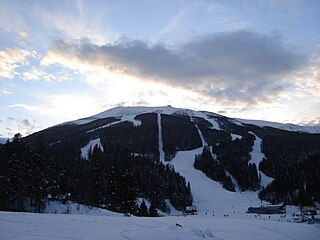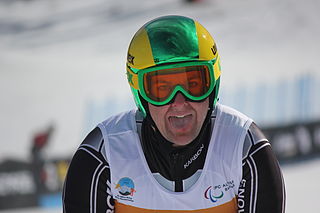
Alpine Skiing at the 1984 Winter Olympics consisted of six alpine skiing events, held 13–19 February in Sarajevo, Yugoslavia. The men's races were at Bjelašnica and the women's at Jahorina. Due to weather delays, both downhill races were postponed several days and run after the giant slalom races.

Paralympic alpine skiing is an adaptation of alpine skiing for athletes with a disability. The sport evolved from the efforts of disabled veterans in Germany and Austria during and after the Second World War. The sport is governed by the International Paralympic Committee Sports Committee. The primary equipment used includes outrigger skis, sit-skis, and mono-skis. Para-alpine skiing disciplines include the Downhill, Super-G, Giant slalom, Slalom, Super Combined and Snowboard.
Disabled skiing was an Olympic demonstration sport for the first time at the 1984 Winter Olympics. There was alpine giant slalom held for men only, with medals awarded in four different standing disability classes. As a demonstration sport, these medals did not contribute to the overall medal count. These races were held in addition to the alpine and cross-country events at the 1984 Winter Paralympics in Innsbruck. Disabled skiing would be demonstrated at the Olympics again in 1988. A total of 29 disabled skiers from 11 nations participated in the 1984 Games.

The Winter Paralympic Games is an international multi-sport event where athletes with physical disabilities compete in snow and ice sports. The event includes athletes with mobility impairments, amputations, blindness, and cerebral palsy. The Winter Paralympic Games are held every four years directly following the Winter Olympic Games and hosted in the same city. The International Paralympic Committee (IPC) oversees the Games. Medals are awarded in each event: with gold for first place, silver for second, and bronze for third, following the tradition that the Olympic Games began in 1904.

The 1984 Winter Paralympics, then known as The Third World Winter Games for the Disabled, were held in Innsbruck, Austria. The games took place from the 15 until 21 January. Present at these games were 419 athletes from 21 countries, Spain and the Netherlands competing for the first time in the Winter Paralympics, competing in 107 events across 3 sports. The inclusion of Les Austres and Cerebral palsy impairment groups contributing to the distinct increase in athlete participation with the total number of athletes jumping from 229 at Geilo, Norway in 1980.

Australia sent a delegation to compete at the 1988 Winter Paralympics in Innsbruck, Austria, which was held between 17–24 January 1988. This marked the nation's fourth appearance at the Winter Paralympics. The delegation sent a group of five alpine skiers as they wouldn't get a medal in these games.

The 1994 Winter Paralympics were held in Lillehammer, Norway. Australia sent six male skiers, who won three gold, two silver and four bronze medals. Australia, at the time, achieved their best ever performance at a Winter Paralympics, finishing 5th overall in the alpine skiing competition, 9th in the medal standings, and 11th in the total medal count out of 31 nations.
LW12 is a para-Alpine and para-Nordic sit skiing sport class defined by the International Paralympic Committee (IPC). An LW12 skier needs to meet a minimum of one of several conditions including a single below knee but above ankle amputation, monoplegia that exhibits similar to below knee amputation, legs of different length where there is at least a 7 centimetres difference, combined muscle strength in the lower extremities less than 71. For international competitions, classification is done through IPC Alpine Skiing or IPC Nordic Skiing. For sub-international competitions, classification is done by a national federation such as Alpine Canada. For para-Alpine, this class is subdivided into two subclasses.: LW12.1 and LW12.2. A new sit-skier competitor with only national classification will compete as LW12.2 in international competitions until they have been internationally classified.

LW1 is a para-Alpine standing skiing classification for people with severe lower extreme disabilities in both extremities. It includes both skiers with amputations and cerebral palsy. International classification is done through International Paralympic Committee Alpine Skiing, and national classification through local national sport federations. LW1 classified skiers use outriggers, and two skis or one ski with a prosthesis. Other equipment is used during training such as ski-tips, ski-bras, and short skis.

LW2 is a para-Alpine and para-Nordic standing ski sport class defined by the International Paralympic Committee (IPC). Competitors in this class have severe disability in a lower limb, which may be a result of an amputation, or arthrodesis in the leg and hip. Depending on the type of skiing, the international classification process for LW2 skiers is handled by the IPC Alpine Skiing Technical Committee and IPC Nordic Skiing Technical Committee. National sport federations handle classification on the lower levels.
LW3 is a para-Alpine and para-Nordic standing skiing sport class defined by the International Paralympic Committee (IPC) for skiers with a disability affecting both legs, with double below knee amputation or a combined strength total for both legs of 60, with 80 as the baseline for people without disabilities. For international skiing competitions, classification is done through IPC Alpine Skiing or IPC Nordic Skiing. The classification has two subclasses for para-Alpine skiing: LW3.1 which is for people with double below the knee amputations or similar disabilities, and LW3.2 which is for people with cerebral palsy that involves moderate athetoid, moderate ataxic impairment or slight diplegic involvement.
LW5/7 is a standing para-Alpine and para-Nordic skiing classification for skiers with upper extremity issues in both limbs that may include double amputation of both arms and hands or dysmelia of the upper limbs. The class has three subclasses defined by the location of the disability on the upper extremities. International classification is done by IPC Alpine Skiing and IPC Nordic Skiing. On the national level, classification is handled by national sports federation such as Cross-Country Canada.

LW6/8 is a para-Alpine and para-Nordic standing skiing sport class, a classification defined by the International Paralympic Committee (IPC) for people with an upper extremity issue who have paralysis, motor paresis affecting one arm, a single upper arm amputation or CP8 classified cerebral palsy. LW6/8 skiers use two skis and one pole in both para-Alpine and para-Nordic skiing.

Chile sent a delegation to compete at the 2014 Winter Paralympics in Sochi, Russia from 7–16 March 2014. This was Chile's fourth participation in a Winter Paralympic Games. The Chilean delegation consisted of two alpine skiers, Jorge Migueles and Santiago Vega. Migueles finished 25th in the men's standing slalom and 20th in the men's standing giant slalom, while Vega finished 32nd in the regular slalom.

Armenia sent a delegation to compete at the 2014 Winter Paralympics in Sochi, Russia from 7–16 March 2014. This was the nation's fifth appearance at a Winter Paralympic Games. The delegation consisted of a single alpine skier, Mher Avanesyan, who lost both arms as a child after coming into contact with a high-voltage electrical wire. In the men's standing slalom he came in 34th place out of 35 competitors who finished the race, and he failed to finish the giant slalom.

Bosnia and Herzegovina sent a delegation to compete at the 2014 Winter Paralympics in Sochi, Russia from 7–16 March 2014. This was the second time the country had participated in a Winter Paralympic Games. The delegation consisted of two alpine skiers, Senad Turkovic and Ilma Kazazic. Neither of the two finished any of their events.

Denmark sent a delegation to compete at the 2014 Winter Paralympics in Sochi, Russia from 7–16 March 2014. This was Denmark's tenth appearance at a Winter Paralympic Games. The Danish delegation to Sochi consisted of two alpine skiers, Ulrik Nyvold and Line Damgaard. Nyvold failed to finish either of his events, while Damgaard placed 12th in the women's standing slalom and 15th in the women's standing giant slalom.

New Zealand sent a delegation to compete at the 2014 Winter Paralympics in Sochi, Russia, held between 7–16 March 2014. The country continued its streak of competing in every Winter Paralympics since 1984. New Zealand's delegation consisted of three competitors in alpine skiing, one of whom, Corey Peters, won a silver medal in the giant slalom. With one silver medal, the country tied for 16th on the medal table for these Paralympics.

The Netherlands sent a delegation to compete at the 2014 Winter Paralympics in Sochi, Russia, held between 7–16 March 2014. The Netherlands delegation consisted of seven competitors, all of which were competing in sports under the alpine skiing banner. Bibian Mentel won the nation's only medal at these Paralympics, a gold in women's snowboard cross. With one gold medal, the Netherlands ranked a joint 14th place on the medal table with Switzerland.












